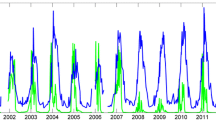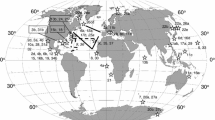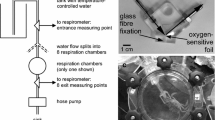Abstract
The gill-surface area and R-T (metabolic rate-temperature) response during aquatic and aerial respiration of three different species of crabs, the subtidal Scylla serrata, the intertidal Sesarma quadratum, and the supratidal Ocypoda platytarsis, were compared. Scylla serrata has the highest, Sesarma quadratum the second highest, and O.platytarsis the lowest gill-surface area. Oxygen-consumption values in water under different ambient partial pressures of oxygen indicate that all three species display equally efficient aquatic respiration despite variation in gill area and number. There is no coherent R-T response either inter- or intra-specifically. However, the ability to extract oxygen from the surrounding medium (respiratory efficiency) conditions the R-T response in the different species. The R-T trends in aquatic respiration of Scylla serrata and aerial respiration of O.platytarsis reveal a normal response to temperature. The proportion of aquaticoxygen uptake to total respiration in all sizes in both Scylla serrata and Sesarma quadratum remains more or less constant (between 88 and 92%), whereas in the supratidal O.platytarsis, this proportion decreases with increasing weight (from 88 to 64 %), indicating a progressive loss of gill respiration to total respiration. All three species are metabolically equally efficient; what one lacks in respiratory surface it compensates by respiratory efficiency.
Similar content being viewed by others
Literature Cited
Ayers, J.C.: Relationship of habitat to oxygen consumption by certain estuarine crabs. Ecology 19, 523–527 (1938)
Berg, T. and J.B. Steen: Physiological mechanisms for aerial respiration in the eel. Comp. Biolchem. Physiol. 15, 469–484 (1965)
Bliss, D.E. and L.H. Mantel: Adaptations of crustaceans to land: a summary and analysis of new findings. Am. Zool. 8, 673–685 (1968)
Carter, G.S.: Aquatic and aerial respiration in animals. Biol. Rev. 6, 1–35 (1931)
Chen, T.Y.: The effect of oxygen tension on the oxygen consumption of the Chinese fresh water crab, Eriocheir sinensis. Chin. J. Physiol. 6, 1–12 (1932)
Dehnel, P.A.: Effect of temperature and salinity on the oxygen consumption of two intertidal crabs. Biol. Bull. mar. biol. Lab., Woods Hole 118, 215–249 (1960)
Edney, E.B.: Terrestrial adaptation. In: The physiology of Crustacea, Vol I. pp 367–393. Ed. by T.H. Waterman. New York: Academic Press 1960
Fox, H.M. and E.J. Baldes: The vapour pressures of the blood of arthropods from swift and still fresh waters. J. exp. Biol. 12, 174–178 (1935)
— and C.A. Wingfield: Activity of Pandalus from different latidudes. Proc. zool. Soc. Lond. (Ser. A) 107, 275–282 (1937)
Flemister, L.J. and S.C. Flemister: Chloride ion regulation and oxygen consumption in the crab, Ocypode albicans (Bosq). Biol. Bull. mar. biol. Lab., Woods Hole 101, 259–273 (1951)
Fry, F.E.J.: Animals in aquatic environments: fishes. In: Handbook of physiology. Section 4. Adaptation to environment, pp 715–728. Ed. by E. Dill, F. Adolph and C.G. Wilber. Washington, D.C.: American Physiological Society 1964
Gray, I.E.: A comparative study of the gill area of crabs. Biol. Bull. mar. biol. Lab., Woods Hole 112, 34–42 (1957)
Harms, J.W.: Die Realisation von Genen und die consecutive Adaptation. II. Birgus latre. L. als Landkrebs und seine Beziehungen zu den Coenobiten. Z. wiss. Zool. 140, 167–290 (1932)
Hart, J.S.: The circulation and respiratory tolerance of some Florida fresh water fishes. Proc. Fla Acad. Sci. 7, 221–246 (1945)
Jalal, M.A.: Studies on respiration of air breathing fishes, 67 pp. M. Sc. Thesis, Madras University 1962
Jeuken, M.: A study of the respiration of Misgurnus fossilus (L), the pond loach, 114 pp. Ph.D. Dissertation, Rijksuniveriteit, Leiden 1957
Job, S.V.: The oxygen consumption of Salvelinus fontinalus. Univ. Toronto Stud. Biol. Ser. 61 (Publs Ont. Fish. Res. Lab. 73, 1–39) (1955)
Kinne, O.: Adaptation, a primary mechanism of evolution. In: Phylogeny and evolution of Crustacea, pp 27–50. Ed. by H.B. Whittington and W.D.I. Rolfe. Cambridge, Mass.: Museum of Comparative Zoology (Spec. Publ.) 1963
— Temperature: animals —invertebrates. In: Marine ecology, Vol. I. Environmental factors, Pt 1. pp 407–514. Ed. by O. Kinne. London: Wiley-Interscience 1970
— (Ed.): Marine ecology, Vol. I. London: Wiley-Interscience 1970–1972
Kottil, A.J.: Studies on the respiration of air breathing fishes, 117 pp. Ph.D. Thesis. Madras University 1963
Munz. F.W. and R.W. Morris: Metabolic rate of hay fish, Eptatretus stoutii (Lockington). Comp. Biochem. Physiol. 16, 1–6 (1965)
Newell, R.C.: Effect of temperature on the metabolism of poikilotherms. Nature, Sobo 22, 426–428 (1966)
Pearse, A.S.: Observations on certain littoral and terrestrial animals at Tortugas, Florida with special reference to migrations from marine to terrestrial habitats. Pap. Tortugas Lab. 26, 205–237 (1929a)
—: The ecology of certain estuarine crabs at Beaufort, N.C. J. Elisha Mitchell scient. Soc. 44, 230–237 (1929b)
Precht, H.: Concepts of the adaptation of unchanging reaction systems of cold blooded animals. In: Physiological adaptation, pp 50–78. New York: Ronald Press Co. 1958
Prosser, C.L. and F.A. Brown: Comparative animal physiology, 2nd ed. 688 pp. Philadelphia, Pa.: Saunders 1961
Raben, K. Van: Veränderungen in dem Kiemendeckel und in den Kiemen einiger Brachyurean (Decapoden) im Verlauf der Anpassung an die Feuchtluftatmung. Z. wiss. Zool. 145, 425–461 (1934)
Schneider, D.E.: An evaluation of temperature adaptation in latitudinally separated poputations of the xanthid crab, Rhithropanopeus harrisii (Gould) by laboratory rearing experiments. Ph. D. Dissertation, Duke University 1967
Subrahmanyam, C.B.: Oxygen consumption in relation to body weight and oxygen tension in the prawn, Penaeus indicus (Milne Edwards). Proc. Indian Acad. Sci. 55, 152–161 (1962)
Teal, J.M.: Respiration of crabs in Georgia Salt marshes and its relation to their ecology. Physiol. Zoöl. 32, 1–14 (1959)
— and F.G. Carey: The metabolism of marsh crabs under conditions of reduced oxygen pressure. Physiol. Zoöl. 40, 83–91 (1967)
Van Wheel, P.B., J.E. Randall and M. Takota: Observations on the oxygen consumption of certain marine Crustacea. Pacif. Sci. 8, 209–218 (1954)
Veerannan, K.M.: Respiratory metabolism of crabs from marine and estuarine habitats. I. Scylla serrata. Mar. Biol. 17, 284–290 (1972)
Vernberg, F.J.: Study of the oxygen consumption of excised tissue of certain marine decapod crustacean in relation to habitat. Physiol. Zoöl. 29, 227–234 (1956)
—: Studies on the physiological variation between tropical and temperate zone fiddler crabs of the genus, Uca. II. Oxygen consumption of whole organisms. Biol. Bull. mar. biol. Lab., Woods Hole. 117, 163–184 (1959)
— and W.B. Vernberg: Interrelationships between parasites and their hosts: comparative metabolic pattern of thermal acclimation of larval treamatodes with that of their hosts. Comp. Biolchem. Physiol. 14, 557–566 (1965)
Vernberg, W.B. and F.J. Vernberg: Physiological diversity of metabolism in marine and terrestrial Crustacea. Am. Zool. 8, 449–458 (1968)
——: Environmental physiology of marine animals, 346 pp. New York: Springer-Verlag 1972
Wolvekamp, H.P. and T.H. Waterman: Respiration. In: The physiology of Crustacea, Vol. I. pp 35–100. Ed. by T.H. Waterman. New York: Academic Press 1960
Author information
Authors and Affiliations
Additional information
Communicated by N.K. Pannikar, New Delhi
This paper formed part of a thesis approved for the award of the degree of Doctor of Philosophy by the Madras University, India.
Rights and permissions
About this article
Cite this article
Veerannan, K.M. Respiratory metabolism of crabs from marine and estuarine habitats: an interspecific comparison. Mar. Biol. 26, 35–43 (1974). https://doi.org/10.1007/BF00389084
Accepted:
Published:
Issue Date:
DOI: https://doi.org/10.1007/BF00389084




